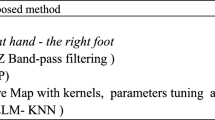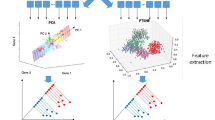Abstract
As connections from the brain to an external device, Brain-Computer Interface (BCI) systems are a crucial aspect of assisted communication and control. When equipped with well-designed feature extraction and classification approaches, information can be accurately acquired from the brain using such systems. The Hierarchical Extreme Learning Machine (HELM) has been developed as an effective and accurate classification approach due to its deep structure and extreme learning mechanism. A classification system for motor imagery EEG signals is proposed based on the HELM combined with a kernel, herein called the Kernel Hierarchical Extreme Learning Machine (KHELM). Principle Component Analysis (PCA) is used to reduce the dimensionality of the data, and Linear Discriminant Analysis (LDA) is introduced to push the features away from different classes. To demonstrate the performance, the proposed system is applied to the BCI competition 2003 Dataset Ia, and the results are compared with those from state-of-the-art methods; we find that the accuracy is up to 94.54%.






Similar content being viewed by others
References
Blankertz B, Muller K-R, Curio G, Vaughan TM, Schalk G, Wolpaw JR, Schlogl A, Neuper C, Pfurtscheller G, Hinterberger T, Schroder M, Birbaumer N. The BCI, competition 2003: progress and perspectives in detection and discrimination of EEG single trials. IEEE Trans Biomed Eng 2004;51(6):1044–1051.
Buzsȧki G, Anastassiou CA, Koch C. The origin of extracellular fields and currents — EEG, ECoG, LFP and spikes. Nat Rev Neurosci 2012;13(6):407–420.
Camps-Valls G, Bruzzone L. Kernel-based methods for hyperspectral image classification. IEEE Trans Geosci Remote Sens 2005;43(6):1351–1362.
da Silva FL. EEG and MEG: relevance to neuroscience. Neuron 2013;80(5):1112–1128.
Deng CW, Huang GB, Jia Xu, Tang JX. Extreme learning machines: new trends and applications. Sci Chin Inf Sci 2015;58(2):1–16.
Duan L, Qi Z, Yang Z, Miao J. Research on heuristic feature extraction and classification of eeg signal based on bci data set. Res J Appl Sci Eng Technol 2013;5(3):1008–1014.
Duan L, Zhong H, Miao J, Yang Z, Ma W, Zhang X. A voting optimized strategy based on ELM for improving classification of motor imagery BCI data. Cogn Comput 2014;6(3):477–483.
Guest editorial the third international meeting on brain-computer interface technology. Making a difference. IEEE Trans Neural Syst Rehab Eng 2006;14(2):126–127.
Huang GB. An insight into extreme learning machines: random neurons, random features and kernels. Cogn Comput 2014;6(3):376–390.
Huang G-B, Wang DH, Lan Y. Extreme learning machines: a survey. Int J Mach Learn Cybern 2011; 2(2):107–122.
Huang G-B, Zhu Q-Y, Siew C-K. Extreme learning machine: a new learning scheme of feedforward neural networks. In: 2004 IEEE international joint conference on neural networks (IEEE Cat. No.04CH37541). Institute of Electrical and Electronics Engineers (IEEE).
Huang G-B, Zhu Q-Y, Siew C-K. Extreme learning machine: theory and applications. Neurocomputing 2006;70(1–3):489–501.
Jolliffe IT. Principal component analysis and factor analysis. In: Principal component analysis. Springer Nature; 1986 p 115–128.
Kayikcioglu T, Aydemir O. A polynomial fitting and k-NN based approach for improving classification of motor imagery BCI data. Pattern Recogn Lett 2010;31(11):1207–1215.
LeVan P, Urrestarazu E, Gotman J. A system for automatic artifact removal in ictal scalp EEG based on independent component analysis and bayesian classification. Clin Neurophysiol 2006;117(4):912–927.
Li X, Hu B, Shen J, Xu T, Retcliffe M. Mild depression detection of college students: an EEG-based solution with free viewing tasks. J Med Syst. 2015; 39(12).
Mensh BD, Werfel J, Seung HS. BCI competition 2003—data set ia: Combining gamma-band power with slow cortical potentials to improve single-trial classification of electroencephalographic signals. IEEE Trans Biomed Eng 2004;51(6):1052–1056.
Nicolas-Alonso LF, Corralejo R, Gomez-Pilar J, Ȧlvarez D, Hornero R. Adaptive semi-supervised classification to reduce intersession non-stationarity in multiclass motor imagery-based brain–computer interfaces. Neurocomputing 2015;159:186–196.
Panahi N, Shayesteh MG, Mihandoost S, Varghahan BZ. Recognition of different datasets using PCA, LDA, and various classifiers. In: 2011 5th International conference on application of information and communication technologies (AICT). Institute of Electrical and Electronics Engineers (IEEE); 2011.
Pfurtscheller G, Neuper C, Schlogl A, Lugger K. Separability of EEG signals recorded during right and left motor imagery using adaptive autoregressive parameters. IEEE Trans Rehab Eng 1998;6(3):316–325.
Pfurtscheller G, Neuper Ch, Flotzinger D, Pregenzer M. EEG-based discrimination between imagination of right and left hand movement. Electroencephalogr Clin Neurophysiol 1997;103(6):642–651.
Subasi A, Erċelebi E. Classification of EEG signals using neural network and logistic regression. Comput Methods Programs Biomed 2005;78(2):87–99.
Sun S, Zhang C. 2005. Assessing features for electroencephalographic signal categorization. In: Proceedings. (ICASSP 05). IEEE international conference on acoustics, speech, and signal processing. Institute of Electrical and Electronics Engineers (IEEE);
Tang J, Deng C, Huang G-B. Extreme learning machine for multilayer perceptron. IEEE Trans Neural Netw Learn Syst 2016;27(4):809–821.
Ting W, Guo-zheng Y, Bang-hua Y, Sun H. EEG feature extraction based on wavelet packet decomposition for brain computer interface. Measurement 2008;41(6):618–625.
Vecchiato G, Susac A, Margeti S, De Vico Fallani F, Maglione AG, Supek S, Planinic M, Babiloni F. High-resolution EEG analysis of power spectral density maps and coherence networks in a proportional reasoning task. Brain Topogr. 2012;26(2):303–314.
Wang B, Jun L, Bai J, Peng L, Li G, Li Y. EEG recognition based on multiple types of information by using wavelet packet transform and neural networks. In: 2005 IEEE Engineering in medicine and biology 27th annual conference. Institute of Electrical and Electronics Engineers (IEEE); 2005.
Wolpaw JR, Birbaumer N, Heetderks WJ, McFarland DJ, Peckham PH, Schalk G, Donchin E, Quatrano LA, Robinson CJ, Vaughan TM. Brain-computer interface technology: a review of the first international meeting. IEEE Trans Rehab Eng 2000;8(2):164–173.
Zandi AS, Javidan M, Dumont GA, Tafreshi R. Automated real-time epileptic seizure detection in scalp EEG recordings using an algorithm based on wavelet packet transform. IEEE Trans Biomed Eng 2010;57(7): 1639–1651.
Zhou W, Liu Y, Yuan Q, Li X. Epileptic seizure detection using lacunarity and bayesian linear discriminant analysis in intracranial EEG. IEEE Trans Biomed Eng 2013;60(12):3375– 3381.
Zong W, Huang G-B, Chen Y. Weighted extreme learning machine for imbalance learning. Neurocomputing 2013;101:229–242.
Acknowledgements
This research is partially sponsored by the Natural Science Foundation of China (Nos. 61672070, 81471770, 61572004 and 61650201), the Beijing Municipal Natural Science Foundation (4152005, 4162058), the Science and Technology Program of Tianjin (15YFXQGX0050), and the Qinghai Natural Science Foundation (2016-ZJ-Y04).
Author information
Authors and Affiliations
Corresponding author
Ethics declarations
Conflict of Interest
The authors declare that they have no conflicts of interest.
Informed Consent
Informed consent was not required, as no humans or animals were involved.
Human and Animal Rights
This article does not contain any studies with human participants or animals performed by any of the authors.
Rights and permissions
About this article
Cite this article
Duan, L., Bao, M., Cui, S. et al. Motor Imagery EEG Classification Based on Kernel Hierarchical Extreme Learning Machine. Cogn Comput 9, 758–765 (2017). https://doi.org/10.1007/s12559-017-9494-0
Received:
Accepted:
Published:
Issue Date:
DOI: https://doi.org/10.1007/s12559-017-9494-0




